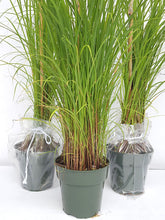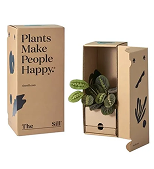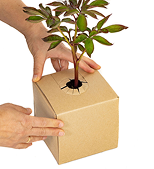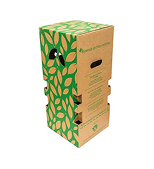- Home
- Ornamental Plants
- Citronella grass - Herbs...
Citronella grass - Herbs & Kitchen Plants











Citronella grass - Herbs & Kitchen Plants

 Climate
Climate Time to yield
Time to yield Maximum size
Maximum size


Damaged or lifeless? We’ll replace it for free. Learn more




Double layered custom boxes to protect plants during shipping.

Air vents for proper air-flow

To preserve plant freshness during transit

Details steps of how to grow and maintain your plant
Citronella grass is botanically known as Cymbopogon nardus from the grass family, Poaceae. It is commonly cultivated as a culinary and medicinal herb because of its scent, resembling that of lemons. It have magenta-colored base stems. These species are used for the production of citronella oil, which is used in soaps, as an insect repellent (especially mosquitoes and houseflies) in insect sprays and candles, and in aromatherapy. Besides oil production, citronella grass is also used for culinary purposes, as a flavoring.
What does make it Special??
- The leaves and the oil are used to make medicine.
- It is commonly taken orally, applied directly to the skin, or inhaled as aromatherapy for many different conditions. But there is limited scientific research to support any of its common uses.
- Plant leaves & stalks are preserved in dried form to use for future purposes.
MAXIMUM HEIGHT - Upto 2 meters in height, but it also depends on its maturity & its location.
BLOOMING YEAR - Flowers are inconspicuous, but they are popular for their leaves.
GROWING TIPS
- As it belongs to the grass family, so it is very easy to grow it without much effort.
- Full sun is great but a balcony with 2 to 3 hours of indirect bright light will also be sufficient.
-
Regular water is required. Plant it in large pots for getting big healthy leaves.
- When choosing a container, be sure to pick one that has at least one drainage hole in the bottom. This is key as the hole will allow excess water to drain out.
- As the plant will grow, the old leaves will get dried, so regularly clean the planting area.
SUITABLE LOCATION
Shaded Balcony, Sunny Balcony, Door Entrance, Hanging basket, Best Attractive & Zero Maintenance Plant, Border Plant, Kitchen's window.
INSIDE THE BOX
| S.No. | PRODUCT NAME | DIMENSION |
| 1. | Citronella grass Plant | 1-2 Feet Height |
| 2. | Growing Pot (Black color) | 4-6 Inch |
*above specifications are for indicative purposes only, actual dimensions may slightly vary.
PLANT CARE
LIGHT CONDITION - Can grow in Indirect Bright light or Semi shade and in Direct sunlight also.
WATERING SCHEDULE - Water when the topsoil(2-3 inches) feels dry to touch.
SOIL TYPE - The soil should be well-drained, fertile, and rich in organic content, sandy soil is most preferred.
TEMPERATURE - The average temperature should be 18-30 Degree Celsius.
FERTILIZER APPLICATION - Apply any organic fertilizer once a month and stop in winter.
PLANT PROTECTION - Remove dead, infected, or damaged plant parts and discard them away from the plants.
INITIAL CARE FOR 10-15 DAYS JUST AFTER RECEIVING YOUR PLANT
- Remove the Packaging Materials carefully.
- Press the soil in the pot & add additional soil(garden mix) if necessary.
- Maintain moisture in the pot, Do not overwater it may kill your plant, so make sure that the soil should be dry between watering.
- Make sure that plants get enough morning direct bright light(2-3hrs) for 10-15 days & do not go for immediate transplanting (minimum 1 month)
- You can remain the plant in the same pot for 6-7 months, later you can transplant it in a slightly bigger pot than the present.
- Just prune if any branch of the plant is get damaged in transits. New leaves will come definitely.
Selected plant of 8-10 inches
Planted into a 5-inch pot
With healthy, moisture-retaining soil
A care instruction sheet for maintenance guide

Get in touch for best pricing on bulk orders and landscaping projects.
 WhatsApp us
WhatsApp us

Call on 9177805454 (Mon-Sat, 9 AM-6 PM) or WhatsApp us – we’re here to help.
About Exotic Flora
At Exotic Flora, we’re passionate about bridging the gap in bringing plants to everyone. With over 500+ varieties across 7 plant categories, from exotic finds to everyday greens, we bring the entire range to you.
Our plants, sourced from all parts of India are nurtured at Kadiyam, in our 25 acres in-house nursery by a team of expert horticulturists. Once they are ready we ship all our plant varieties across India.
Our services go beyond safe delivery of plants. A dedicated support team is there to help you with any maintenance queries you may have.
At Exotic Flora we always believe in going that extra mile, because everyone should have the plants they love.
Every plant has different plant parts to use as a medicinal plant it may be in its leaves, roots, stems, flowers or other parts of the plant. For full details look at the descriptions of individual plants.
Citronella grass, Lemon grass, Rosemary, Marigold, Mint Tulasi etc
Some plants need indirect bright light & others need direct bright light and some can grow in both direct and indirect sunlight. So please look at the description of each individual plants.
The soil should be well drained, fertile and rich in organic content. A mixture of garden soil, cocopeat, compost will give the best results for your plants.
Remember overwater can kill your plant(make sure that your pot should have drainage hole). Water when the topsoil(2-3 inch) feels dry to touch. In general moderate watering(in every 3-4 days)
Regular pruning of diseased and damaged parts of the plants. Regular watering, proper ventilation & sunlight, organic manure & fertilizers application.
In general you can grrow in indirect bright light conditions like basil, rosemary, mint, Centella asiatica, Maghai paan / betel leaf.
Tulsi has been used for thousands of years in Ayurveda for its diverse healing properties apart from devotional purpose.
No, both are different plants, Tulsi which is commonly known as holy basil, where as mint tulsi is closely related to holy basil & doesn't have devotional property.
Stevia is a sugar substitute made from the leaves of the stevia plant. It's about 100 to 300 times sweeter than table sugar, but it has no carbohydrates, calories, or artificial ingredients.
Costus igneus, commonly known as insulin plant in India. Consumption of the leaves are believed to lower blood glucose levels, and diabetics.
Good